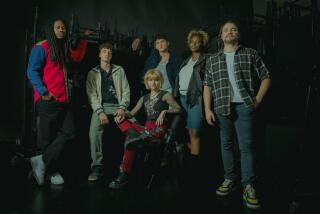Deaf-Blind People Make Seattle Into a Safe Haven : Lighthouse: Facility casts new light on life.
- Share via
SEATTLE — If you can’t see the numbers and you can’t hear the bus driver, how do you know what bus to get on?
Seattle’s strong deaf-blind community came up with an answer--a deck of cards printed with numbers in large type and Braille. Riders hold them up for the driver to see.
The solution came from the Deaf-Blind Community Service Center.
“My work is to help empower deaf-blind people. I don’t complain for them, I teach them how to complain for themselves,” said Mark Landreneau, a case manager at the center.
Seattle has a reputation as a great place for deaf-blind people to live.
“If I’d picked any other city in any other state I wouldn’t have been able to grow in the ways I’ve been able to here,” Landreneau said.
For example, there’s Danny Delcambere, a cook who has a genetic disorder that causes deafness and gradual blindness.
A scholarship paid for his interpreter and support services during an internship in New Orleans with chef Paul Prudhomme. “He wants to set up a small restaurant when he gets back to Seattle. He says the Cajun food here is nothing like it should be,” Landreneau said.
Maria Garden can think of at least 200 deaf-blind people who have moved here since she arrived four years ago. She is a graduate of Gallaudet University in Washington, D.C., the nation’s only college for the deaf.
Garden, 28, is deaf and going blind. She and her deaf husband have a 6-month-old son. Like hundreds of deaf-blind people from across the country, she found work and a vibrant community in Seattle.
Garden oversees a federal grant to teach the deaf-blind independent living skills at the Lighthouse for the Blind.
“Right now we’re working on bank machines. When you can’t see or hear the machine, you have to memorize all the possible menus in the right order. So we made up a Braille card that replicates the screen,” Garden signed.
Washington State Deaf-Blind Citizens was formally incorporated in 1982 and two years later the American Assn. of the Deaf-Blind held its annual convention in Seattle. More than 400 visitors from all 50 states saw what an active group of deaf-blind people could accomplish, Smith said.
Dan Mansfield is one of those movers and shakers. A founder several deaf-blind organizations, he sits on the Governor’s Committee on Disability Issues and Employment.
Mansfield, 42, worked on a word processor at Pacific Northwest Bell. After 12 years his eyesight began to deteriorate.
Mansfield pushed to keep working. He and his boss appealed to Bell President Andrew Smith. Smith called together company vice presidents and told them to find Mansfield a job.
Finally the company created a position of deaf customer services representative, which Mansfield has been for six years.
One of the most popular activities of the year is a two-week camp at Seabeck Center near Bremerton. The Lighthouse for the Blind, which employs 40 deaf-blind workers, has organized it since 1978.
At camp, poles and ropes lead from one building to the other, allowing deaf-blind people to roam the grounds without a guide. Knots in front of buildings serve as “signs.” Seven knots on the rope means it is in front of cabin seven.
Campers go canoeing, horseback riding, ride tandem bikes and dance.
Half of the people who attend the camp are from out of state. Paula Hoffman of the Lighthouse said many of them end up moving here.
“People come from other places where there’s no support, no chance to be with other deaf-blind people,” she said. “It’s like a different world here.”
More to Read
Sign up for Essential California
The most important California stories and recommendations in your inbox every morning.
You may occasionally receive promotional content from the Los Angeles Times.









